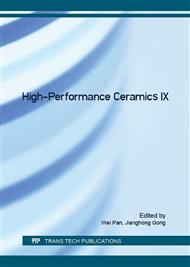[1]
F. Mugele, and J.C. Baret, Electrowetting: from basics to applications, J. Phys.: Condens. Matter, 17 (2005) R705-R774.
DOI: 10.1088/0953-8984/17/28/r01
Google Scholar
[2]
R.B. Fair, Digital microfluidics: is a true lab-on-a-chip possible, Microfluid. Nanofluid. 3 (2007) 245-281.
DOI: 10.1007/s10404-007-0161-8
Google Scholar
[3]
C. Quilliet, and B. Berge, Electrowetting: A recent outbreak, Curr. Opin. Colloid Interface Sci., 6 (2001) 34-39.
DOI: 10.1016/s1359-0294(00)00085-6
Google Scholar
[4]
M.G. Pollack, R.B. Fair, and A.D. Shenderov, Electrowetting-based actuation of liquid droplets for microfluidic applications, Appl. Phys. Lett. 77 (2000) 1725–1727.
DOI: 10.1063/1.1308534
Google Scholar
[5]
J.K. Lee, K.W. Park, H.R. Kim, S.H. Kong, Dielectrically stabilized electrowetting on AF1600/Si3N4/TiO2 dielectric composite film, Sens. Actuators B: Chem. 160 (2011) 1593–1598.
DOI: 10.1016/j.snb.2011.09.074
Google Scholar
[6]
W.Q. Wang, T.B. Jones, and D.R. Harding, On-chip double emulsion droplet assembly using electrowetting-on-dielectric and dielectrophoresis, Fusion Sci. Technol., 59 (2011) 240-249.
DOI: 10.13182/fst59-240
Google Scholar
[7]
H. Moon, S.K. Cho, R.L. Garrell, C. -J. Kim, Low voltage electrowetting-on-dielectric, J. Appl. Phys. 92 (2002) 4080–4087.
DOI: 10.1063/1.1504171
Google Scholar
[8]
Y. Li, W. Parkes, L.I. Haworth, et al., Anodic Ta2O5 for CMOS compatible low voltage electrowetting-on-dielectric device fabrication, Solid-State Electron. 52 (2008) 1382–1387.
DOI: 10.1016/j.sse.2008.04.030
Google Scholar
[9]
Y.Y. Lin, E.R.F. Welch, R.B. Fair, Low voltage picoliter droplet manipulation utilizing electrowetting-on-dielectric platforms, Sens. Actuators B: Chem. 173 (2012) 338–345.
DOI: 10.1016/j.snb.2012.07.022
Google Scholar
[10]
J. -H. Chang, D.Y. Choi, S. Han, J.J. Pak, Driving characteristics of the electrowetting-on-dielectric device using atomic-layer-deposited aluminum oxide as the dielectric, Microfluidics Nanofluidics, 8 (2009) 269–273.
DOI: 10.1007/s10404-009-0511-9
Google Scholar
[11]
Z. -K. Xie, Z. -X. Yue, B. Peng, and L. Li, Effect of PbO excess on the microstructure, dielectric and piezoelectric properties, and energy-storage performance of Bi(Ni1/2Ti1/2)O3–PbTiO3 thin films, Jpn. J. Appl. Phys., 53 (2014) 08NA02.
DOI: 10.7567/jjap.53.08na02
Google Scholar
[12]
Z. -K. Xie, Z. -X. Yue, G. Ruehl, et al., Bi(Ni1/2Zr1/2)O3-PbTiO3 relaxor-ferroelectric films for piezoelectric energy harvesting and electrostatic storage, Appl. Phys. Lett., 104 (2014), 243902.
DOI: 10.1063/1.4884427
Google Scholar
[13]
Y. -Y. Lin, R.D. Evans, E. Welch, et al., Low voltage electrowetting-on-dielectric platform using multi-layer insulators, Sens. Actuators B: Chem. 150 (2010) 465–470.
DOI: 10.1016/j.snb.2010.06.059
Google Scholar


